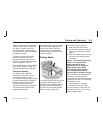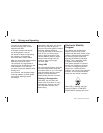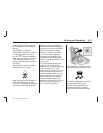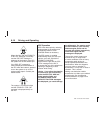
You slam on the brakes and
continue braking. Here is what
happens with ABS:
A computer senses that wheels
are slowing down. If one of
the wheels is about to stop rolling,
the computer will separately
work the brakes at each wheel.
ABS can change the brake pressure
faster than any driver could.
The computer is programmed to
make the most of available tire and
road conditions. This can help
you steer around the obstacle while
braking hard.
As you brake, the computer keeps
receiving updates on wheel speed
and controls braking pressure
accordingly.
Remember: ABS does not change
the time you need to get your
foot up to the brake pedal or always
decrease stopping distance.
If you get too close to the vehicle in
front of you, you will not have
time to apply the brakes if that
vehicle suddenly slows or stops.
Always leave enough room up
ahead to stop, even though
you have ABS.
Using ABS
Do not pump the brakes. Just hold
the brake pedal down firmly and
let antilock work for you. You might
hear the antilock pump or motor
operate, and feel the brake
pedal pulsate, but this is normal.
Braking in Emergencies
With ABS, you can steer and
brake at the same time. In many
emergencies, steering can help
you more than even the very
best braking.
Electronic Stability
Program
The vehicle has the Electronic
Stability Program (ESP
®
) that
assists with directional control of the
vehicle in difficult driving conditions
by reducing engine power and
applying the brakes to individual
wheels. This is especially useful
in slippery road conditions.
The system operates if it senses
that the rear wheels are spinning
too much, are beginning to lose
traction or if it senses that the
vehicle is not moving in its intended
direction. It turns on automatically
every time the vehicle is started.
When ESP is working, this light
and the STABILITY CONTROL
ASSISTANCE message will come
8-16 Driving and Operating
2008 - Pontiac G8 Owner Manual


















